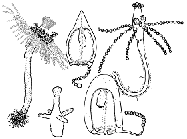WRiMS taxon details
Corymorphidae Allman, 1872
1598 (urn:lsid:marinespecies.org:taxname:1598)
accepted
Family
- Genus Corymorpha M. Sars, 1835
- Genus Euphysora Maas, 1905 accepted as Corymorpha M. Sars, 1835 (synonym)
marine, brackish, fresh, terrestrial
recent only
Allman, G. J. 1872. A monograph of the gymnoblastic or tubularian hydroids. Conclusion of Part I, and Part II, containing descriptions of the genera and species of Gymnoblastea. Ray Society, London, pp. 155-450, plates 1-23., available online at https://doi.org/10.5962/bhl.title.9122
page(s): 386 [details]
page(s): 386 [details]
Schuchert, P.; Choong, H.; Galea, H.; Hoeksema, B.; Lindsay, D.; Manko, M.; Pica, D. (2025). World Hydrozoa Database. Corymorphidae Allman, 1872. Accessed through: Costello, M. J.; Ahyong, S.; Bieler, R.; Boudouresque, C.; Desiderato, A.; Downey, R.; Galil, B. S.; Gollasch, S.; Hutchings, P.; Kamburska, L.; Katsanevakis, S.; Kupriyanova, E.; Lejeusne, C.; Ma, K. C. K.; Marchini, A.; Occhipinti, A.; Pagad, S.; Pino, L.; Poore, G. C. B.; Rewicz, T.; Rius, M.; Robinson, T. B.; Sobczyk, R.; Stepien, A.; Turon, X.; Valls Domedel, G.; Verleye, T.; Vieira, L. M.; Willan, R. C.; Zhan, A. (2025) World Register of Introduced Marine Species (WRiMS) at: https://marinespecies.org/introduced/aphia.php?p=taxdetails&id=1598 on 2025-07-07
Costello, M. J.; Ahyong, S.; Bieler, R.; Boudouresque, C.; Desiderato, A.; Downey, R.; Galil, B. S.; Gollasch, S.; Hutchings, P.; Kamburska, L.; Katsanevakis, S.; Kupriyanova, E.; Lejeusne, C.; Ma, K. C. K.; Marchini, A.; Occhipinti, A.; Pagad, S.; Pino, L.; Poore, G. C. B.; Rewicz, T.; Rius, M.; Robinson, T. B.; Sobczyk, R.; Stępień, A.; Turon, X.; Valls Domedel, G.; Verleye, T.; Vieira, L. M.; Willan, R. C.; Zhan, A. (2025). World Register of Introduced Marine Species (WRiMS). Corymorphidae Allman, 1872. Accessed at: https://www.marinespecies.org/introduced%20/aphia.php/api-docs/aphia.php?p=taxdetails&id=1598 on 2025-07-07
Date
action
by
2004-12-21 15:54:05Z
created
db_admin
original description
Allman, G. J. 1872. A monograph of the gymnoblastic or tubularian hydroids. Conclusion of Part I, and Part II, containing descriptions of the genera and species of Gymnoblastea. Ray Society, London, pp. 155-450, plates 1-23., available online at https://doi.org/10.5962/bhl.title.9122
page(s): 386 [details]
context source (Hexacorallia) Fautin, Daphne G. (2013). Hexacorallians of the World. (look up in IMIS) [details]
basis of record Bouillon, J.; Boero, F. (2000). Synopsis of the families and genera of the Hydromedusae of the world, with a list of the worldwide species. <i>Thalassia Salent. 24</i>: 47-296 (look up in IMIS) [details]
page(s): 386 [details]
context source (Hexacorallia) Fautin, Daphne G. (2013). Hexacorallians of the World. (look up in IMIS) [details]
basis of record Bouillon, J.; Boero, F. (2000). Synopsis of the families and genera of the Hydromedusae of the world, with a list of the worldwide species. <i>Thalassia Salent. 24</i>: 47-296 (look up in IMIS) [details]
 Present
Present  Inaccurate
Inaccurate  Introduced: alien
Introduced: alien  Containing type locality
Containing type locality

